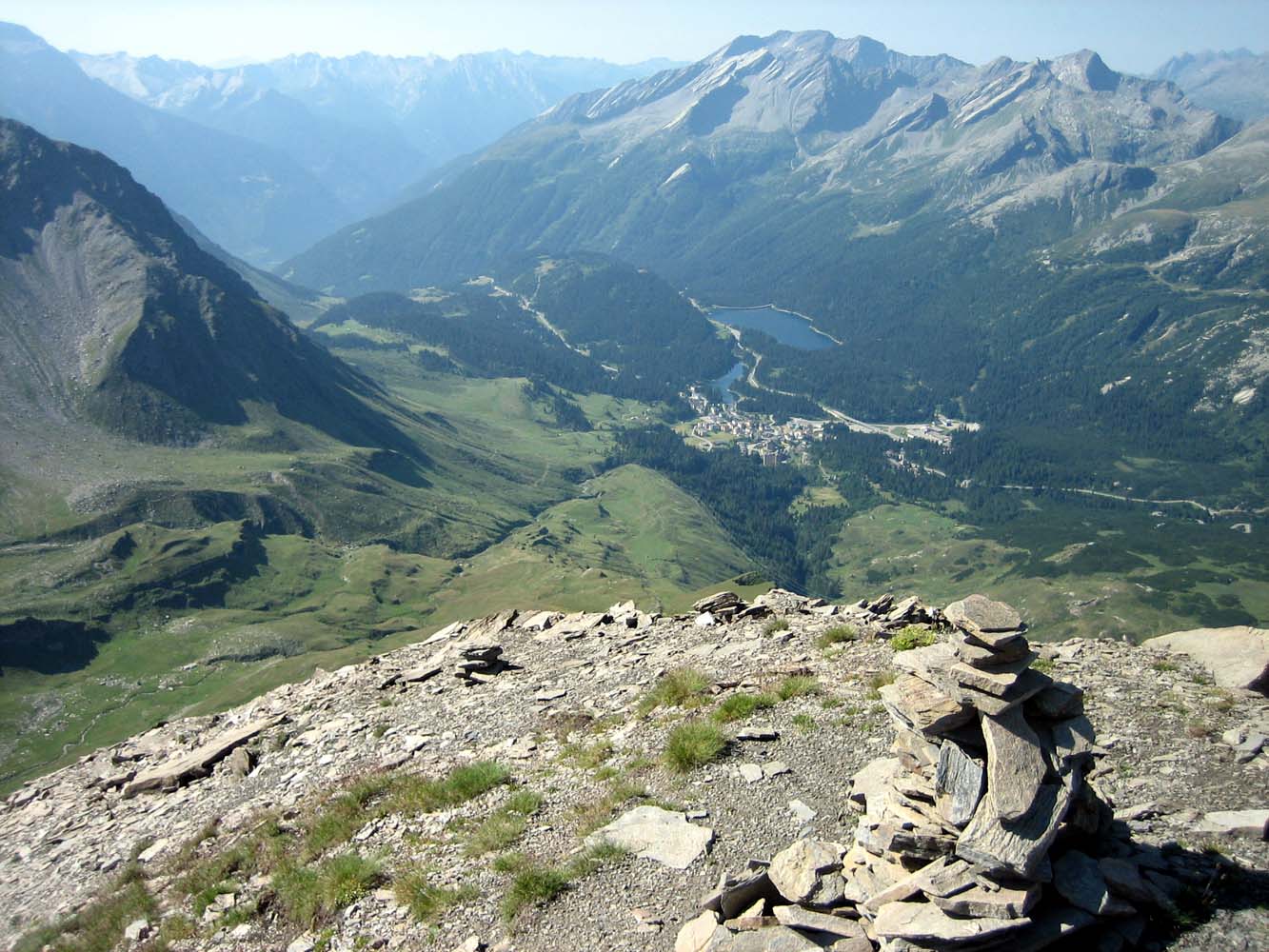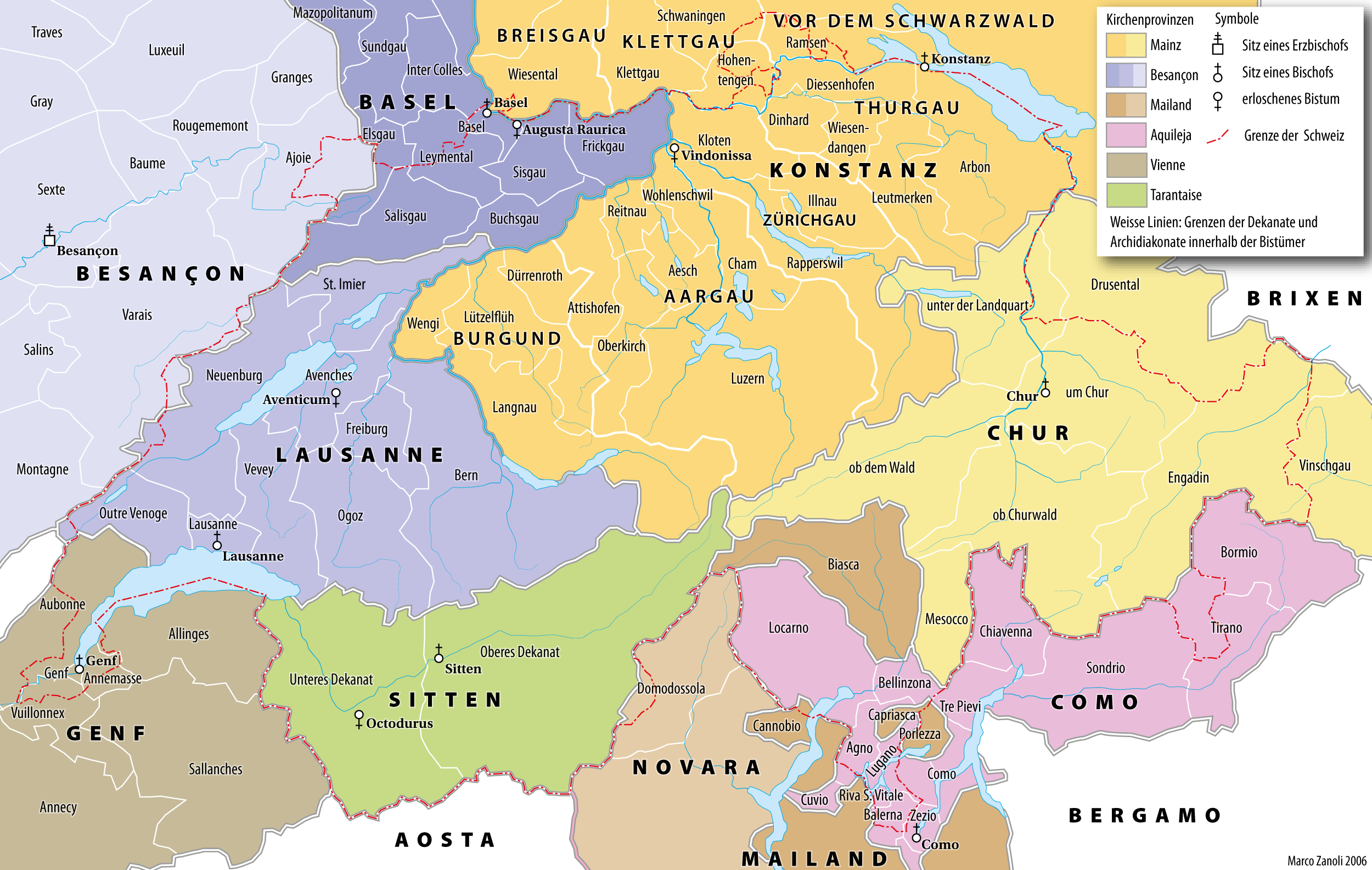|
Splügen Castle
The ruins of the former Splügen Castle (german: Burg Splügen) lie east of the village of Splügen GR, Splügen in the Rheinwald forest in the Swiss canton of Graubünden. It is the only castle in the valley. Location The ruins lie just under one kilometre east of the village on a small hill below the former valley road that ran from the Via Mala over the Splügen Pass, Splügen and San Bernardino Passes. It is an easy ten-minute walk from the village along a lane. It is not possible to drive to the castle. Description The ruins of a fortified, double-winged ''palas'' and an enceinte (''Bering'') are visible on the northern side by the old road. Three of the walls, which are well over a metre thick, have survived; the east wall facing the valley has collapsed. The quoins have a clear border (''Kantenschlag''). One additional wall divides the site into an eastern and western half. The elevated entrance with its Gothic (architecture), Gothic archway, with door jamb, jambs ma ... [...More Info...] [...Related Items...] OR: [Wikipedia] [Google] [Baidu] |
Splügen Von NW
Splügen (Romansh language, Romansh: ''Spleia'', Italian language, Italian: ''Spluga'') is a former municipalities of Switzerland, municipality in the Viamala Region in the Switzerland, Swiss Cantons of Switzerland, canton of Graubünden. On 1 January 2006 Splügen incorporated its neighbouring municipality of Medels im Rheinwald. On 1 January 2019 the former municipalities of Hinterrhein, Switzerland, Hinterrhein, Nufenen and Splügen merged to form the new municipality of Rheinwald, Switzerland, Rheinwald. In 1995, the Swiss Heritage Society bestowed the Wakker Prize to Splügen. History Splügen is first mentioned about 840 as ''cella in Speluca''. Geography Splügen has an area, , of . Of this area, 38.3% is used for agricultural purposes, while 17.8% is forested. Of the rest of the land, 1% is settled (buildings or roads) and the remainder (42.9%) is non-productive (rivers, glaciers or mountains). Before 2017, the municipality was located in the Rheinwald sub-district, ... [...More Info...] [...Related Items...] OR: [Wikipedia] [Google] [Baidu] |
Putlog Hole
Putlog holes or putlock holes are small holes made in the walls of structures to receive the ends of poles (small round logs) or beams, called putlogs or putlocks, to support a scaffolding. Putlog holes may extend through a wall to provide staging on both sides of the wall. A historically common type of scaffolding, putlog holes date from ancient Roman buildings. The term putlock and the newer term putlog date from the 17th century and are still used today. Putlogs may be supported on the outer ends by vertical poles (standards), cantilevered by one end being firmly embedded in the wall, or cantilevered by penetrating the wall to provide scaffolds on both sides. Putlogs may be sawn off flush with the wall if they cannot be removed,Adam, Jean Pierre. ''Roman building: materials and techniques''. Bloomington: Indiana University Press, 1994. 151-152. Print. but exterior putlog holes are typically filled in as the scaffold is removed to prevent water from entering the walls. Interior pu ... [...More Info...] [...Related Items...] OR: [Wikipedia] [Google] [Baidu] |
Misox
The ''Valle Mesolcina'', also known as the ''Val Mesolcina'' or ''Misox'' (German), is an alpine valley of the Grisons, Switzerland, stretching from the San Bernardino Pass to Grono where it joins the Calanca Valley. It is the valley formed by the river Moesa. Like the Val Bregaglia or the Val Poschiavo, the Valle Mesolcina is a valley lying south of the main ridge of the Alps. Although politically the Valle Mesolcina belongs to the Grisons, its population is predominantly Italian-speaking and culturally oriented towards the Ticino. The valley includes the Mesocco and Roveredo of the Moesa district, including: * Mesocco * Soazza * Lostallo * Verdabbio * Cama * Leggia * Grono * Roveredo * San Vittore External links * {{Coord, 46.385, N, 9.235, E, source:frwiki_region:CH, format=dms, display=title Mesolcina The ''Valle Mesolcina'', also known as the ''Val Mesolcina'' or ''Misox'' (German), is an alpine valley of the Grisons, Switzerland, stretching from the San Be ... [...More Info...] [...Related Items...] OR: [Wikipedia] [Google] [Baidu] |
House Of Sax
The noble family von Sax (originally ''de Sacco'') were a medieval noble family in eastern Switzerland. They owned estates and castles on both sides of the Alps in the modern cantons of St. Gallen, Graubünden and Ticino. The origin of the family is unknown, but they probably stem from Churrätien nobility and were related to the da Torre family. The family divided into two main lines; the Grafen (counts) von Sax-Misox and the Freiherren (barons) von Hohensax. Origins The earliest mention of a member of the family is in 1137/39 with Eberhard de Sacco. In 1168, they were granted a fief over the Misox valley, probably as a reward for their support of the Hohenstaufen family. The founder of the line was Albrecht of Sax who first appears in a record in 1188. His brother, Heinrich reorganized the administration of the Abbey of St. Gall and brought it under their authority. Albrecht's sons, Ulrich (first mentioned 1204, died 23 September 1220) and Heinrich (born around 1180, la ... [...More Info...] [...Related Items...] OR: [Wikipedia] [Google] [Baidu] |
House Of Werdenberg
A house is a single-unit residential building. It may range in complexity from a rudimentary hut to a complex structure of wood, masonry, concrete or other material, outfitted with plumbing, electrical, and heating, ventilation, and air conditioning systems.Schoenauer, Norbert (2000). ''6,000 Years of Housing'' (rev. ed.) (New York: W.W. Norton & Company). Houses use a range of different roofing systems to keep precipitation such as rain from getting into the dwelling space. Houses may have doors or locks to secure the dwelling space and protect its inhabitants and contents from burglars or other trespassers. Most conventional modern houses in Western cultures will contain one or more bedrooms and bathrooms, a kitchen or cooking area, and a living room. A house may have a separate dining room, or the eating area may be integrated into another room. Some large houses in North America have a recreation room. In traditional agriculture-oriented societies, domestic animals such as c ... [...More Info...] [...Related Items...] OR: [Wikipedia] [Google] [Baidu] |
Count
Count (feminine: countess) is a historical title of nobility in certain European countries, varying in relative status, generally of middling rank in the hierarchy of nobility. Pine, L. G. ''Titles: How the King Became His Majesty''. New York: Barnes & Noble, 1992. p. 73. . The etymologically related English term "county" denoted the territories associated with the countship. Definition The word ''count'' came into English from the French ''comte'', itself from Latin ''comes''—in its accusative ''comitem''—meaning “companion”, and later “companion of the emperor, delegate of the emperor”. The adjective form of the word is "comital". The British and Irish equivalent is an earl (whose wife is a "countess", for lack of an English term). In the late Roman Empire, the Latin title ''comes'' denoted the high rank of various courtiers and provincial officials, either military or administrative: before Anthemius became emperor in the West in 467, he was a military ''comes ... [...More Info...] [...Related Items...] OR: [Wikipedia] [Google] [Baidu] |
Barons Of Vaz
Baron is a rank of nobility or title of honour, often hereditary, in various European countries, either current or historical. The female equivalent is baroness. Typically, the title denotes an aristocrat who ranks higher than a lord or knight, but lower than a viscount or count. Often, barons hold their fief – their lands and income – directly from the monarch. Barons are less often the vassals of other nobles. In many kingdoms, they were entitled to wear a smaller form of a crown called a '' coronet''. The term originates from the Latin term , via Old French. The use of the title ''baron'' came to England via the Norman Conquest of 1066, then the Normans brought the title to Scotland and Italy. It later spread to Scandinavia and Slavic lands. Etymology The word ''baron'' comes from the Old French , from a Late Latin "man; servant, soldier, mercenary" (so used in Salic law; Alemannic law has in the same sense). The scholar Isidore of Seville in the 7th century thou ... [...More Info...] [...Related Items...] OR: [Wikipedia] [Google] [Baidu] |
Prince-Bishopric Of Chur
The Prince-Bishopric of Chur (german: Hochstift Chur, Fürstbistum Chur, Bistum Chur) was an ecclesiastical principality of the Holy Roman Empire, and had Imperial immediacy. The Prince-Bishopric of Chur controlled contiguous land from the city of Chur, to Engadin, and to Vinschgau. The historical State must be distinguished from the Roman Catholic Diocese of Chur which still exists, even if the bishop was the same man. They were leaded by the League of God's House from the 15th century. The Three Leagues then took over any effettive power from the Prince-Bishopric (while in Vinschgau the control passed to the Habsburg), and after the Reformation the bishop's estates remained the sole territory of the principality. The bishop had the vote number 51 in the Imperial Diet. History The Bishopric of Chur was first founded in 451, when Asinio was made Bishop of Chur. In 1170, Emperor Frederick I raised the Bishopric of Chur to the title of Prince-Bishopric of Chur. In October 1621 ... [...More Info...] [...Related Items...] OR: [Wikipedia] [Google] [Baidu] |
Fief
A fief (; la, feudum) was a central element in medieval contracts based on feudal law. It consisted of a form of property holding or other rights granted by an Lord, overlord to a vassal, who held it in fealty or "in fee" in return for a form of feudal allegiance, services and/or payments. The fees were often lands, land revenue or revenue, revenue-producing real property like a watermill, held in feudal land tenure: these are typically known as fiefs or fiefdoms. However, not only land but anything of value could be held in fee, including governmental office, rights of exploitation such as hunting, fishing or felling trees, monopolies in trade, money rents and tax farms. There never did exist one feudal system, nor did there exist one type of fief. Over the ages, depending on the region, there was a broad variety of customs using the same basic legal principles in many variations. Terminology In ancient Rome, a "benefice" (from the Latin noun , meaning "benefit") was a gif ... [...More Info...] [...Related Items...] OR: [Wikipedia] [Google] [Baidu] |
Schams
thumb , The Schams north of Cagliatscha_Castle.html"_;"title="Andeer.__In_the_top_left,_the_ruins_of_Cagliatscha_Castle">Andeer.__In_the_top_left,_the_ruins_of_Cagliatscha_Castle_ The_Schams_(_rm.html" ;"title="Cagliatscha_Castle_.html" ;"title="Cagliatscha_Castle.html" ;"title="Andeer. In the top left, the ruins of Andeer.__In_the_top_left,_the_ruins_of_Cagliatscha_Castle_">Cagliatscha_Castle.html"_;"title="Andeer.__In_the_top_left,_the_ruins_of_Cagliatscha_Castle">Andeer.__In_the_top_left,_the_ruins_of_Cagliatscha_Castle_ The_Schams_(_rm">(Val)_Schons)_is_a_section_of_the_Hinterrhein_(river).html" ;"title="Cagliatscha Castle">Andeer. In the top left, the ruins of Cagliatscha_Castle.html"_;"title="Andeer.__In_the_top_left,_the_ruins_of_Cagliatscha_Castle">Andeer.__In_the_top_left,_the_ruins_of_Cagliatscha_Castle_ The_Schams_(_rm">(Val)_Schons)_is_a_section_of_the_Hinterrhein_(river)">Hinterrhein_valley_in_the_Switzerland.html" ;"title="Cagliatscha Castle ">Cagliatscha_Cast ... [...More Info...] [...Related Items...] OR: [Wikipedia] [Google] [Baidu] |
Architectural Form
In architecture, form refers to a combination of external appearance, internal structure, and the Unity (aesthetics), unity of the design as a whole, an order created by the architect using #Space and mass, space and mass. External appearance The external outline of a building includes its shape, size, color, and Texture (visual arts), texture), as well as relational property, relational properties, like position, orientation, and visual inertia (appearance of concentration and stability). Architects are primarily concerned with the shapes of the building itself (Contour drawing, contours, silhouettes), its openings (doors and windows), and enclosing planes (floor, walls, ceiling). Forms can have regular shape (stable, usually with an axis or plane of symmetry, like a triangle or pyramid), or irregular; the latter can sometimes be constructed by combining multiple forms (additive forms, composition) or removing one form from another (subtractive forms). Multiple forms can be or ... [...More Info...] [...Related Items...] OR: [Wikipedia] [Google] [Baidu] |











